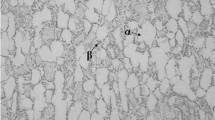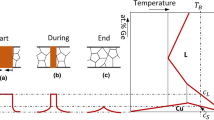Abstract
The dynamic conditions for plastic deformation mechanism, surface source mechanism, interface source mechanism and creep mechanism in the diffusion bonding process are proposed. Based on these dynamic conditions, a model for void closure in the diffusion bonding process is derived. The effects of diffusion bonding parameters on the bonding mechanisms are analyzed. For the diffusion bonding process of TC4 alloy, at a low diffusion bonding temperature or pressure, or for a short time, the interface source mechanism plays a main role. But, the creep mechanism is the dominant mechanism and operates until the diffusion bonding is fulfilled. As the diffusion bonding time increases, the surface source and interface source mechanism enhance and then stop at a certain stage of diffusion bonding, while the creep mechanism enhances continuously. As the diffusion bonding temperature or pressure increases, the interface source mechanism weakens and the other mechanisms enhance. The maximum and average errors between the calculated and the experimental results in the diffusion bonding for TC4 alloy are 12.86% and 5.79%, respectively.
Similar content being viewed by others
References
Elrefaey A, Tillmann W. Solid state diffusion bonding of titanium to steel using a copper base alloy as interlayer. J Mater Process Tech, 2009, 209(5): 2746–2752
Mahendran G, Balasubramanian V, Senthilvelan T. Developing diffusion bonding windows for joining AZ31B magnesium-AA2024 aluminium alloys. Mater Des, 2009, 30(4): 1240–1244
Lagos M, Retamal C. An alternate theoretical approach to solid-state bonding. Scripta Mater, 2011, 64(5): 402–405
Hamilton C H. Titanium Science and Technology. New York: Plenum Press, 1973. 625–648
Garmong G, Paton N E, Argon A S. Attainment of full interfacial contact during diffusion bonding. Metall Mater Trans A, 1975, 6(7): 1268–1279
Derby B, Wallach E R. Theoretical model for diffusion bonding. Metal Sci, 1982, 16(1): 49–56
Derby B, Wallach E R. Diffusion bolding: Development of theoretical model. Metal Sci, 1984, 18(1): 427–431
Hill A, Wallach E R. Modeling solid-state diffusion bonding. Acta Metall, 1989, 37(19): 2425–2437
Orhan N, Eroglu M. A new model for diffusion bonding and its application to duplex alloys. Mater Sci Eng A, 1999, 271: 458–468
Wu G Q, Li Z F, Luo G X, et al. Dynamic simulation of solid-state diffusion bonding. Mater Sci Eng A, 2007, 452–453: 529–535
Johnson W, Sowerby R, Venter R D. Plane Strain Slip Line Fields for Metal Deformation Processes. Oxford: Pergamon Press, 1982. 119–121
Mullins W W. Solid surface morphologies governed by capillarity. In: Robertson W D, Gjostein N A, eds. Metal Surfaces: Structure, Energetics and Kinetics. ASM, Cleveland Ohio, 1963. 17
Kuczynski G C. Self-diffusion in sintering of metallic particles. Trans Am Inst Min Eng, 1949, 185: 169–178
Chen I W, Argon A S. Diffusion growth of grain-boundary cavities. Acta Metall, 1981, 29(10): 1759–1768
Johnson D L. New method of obtaining volume, grain-boundary, and surface diffusion coefficients from sintering data. J Appl Phys, 1969, 40(1): 192–200
Sargent P M, Ashby M F. Deformation maps for titanium and zirconium. Scripta Mater, 1982, 16(12): 1422–1451
Author information
Authors and Affiliations
Corresponding author
Rights and permissions
About this article
Cite this article
Ma, R., Li, M., Li, H. et al. Modeling of void closure in diffusion bonding process based on dynamic conditions. Sci. China Technol. Sci. 55, 2420–2431 (2012). https://doi.org/10.1007/s11431-012-4927-1
Received:
Accepted:
Published:
Issue Date:
DOI: https://doi.org/10.1007/s11431-012-4927-1




